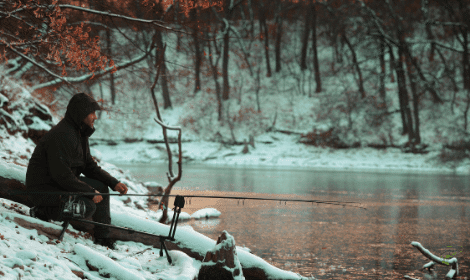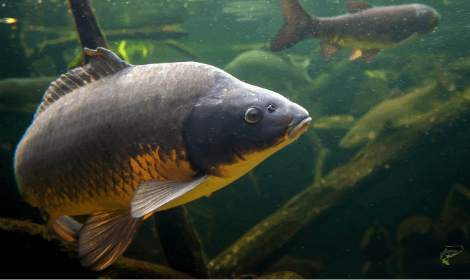
Do carp feed in the winter? Well, yes they do. Many carp anglers thought in years past that carp feed little if never in the winter months, but this is almost never the case, let’s take a deeper look at a carps feeding habits in the winter months.
Do Carp Feed in Winter?
Yes, carp do feed in the winter, but it’s highly dependent on the conditions. Due to carp like all fish being cold-blooded, their body temperature is the same as their environment, so when water temperatures get cold in the winter months, a carp’s metabolism will slow considerably, but they still need to feed at some level.
Depending on the body of water you fish, fishing carp in the winter months can become predictable if you pay your due diligence. Carp may only feed once or twice a day, and these feeding windows can be incredibly short, less than an hour in most cases, and even as little as 15 to 20 minutes.
Your job as an angler fishing in the winter months will be to dial in the locations of the carp in winter and exactly when this feeding window occurs on a daily basis. Once you dial in these two key factors, you can limit your fishing to these feeding windows to make your winter fishing incredibly efficient.
These windows can remain consistent for long periods of time, even throughout the winter if there are no drastic changes in conditions or water temperatures.
If the water were to get very cold and drop below 39 degrees for an extended period of time, the carp will most likely enter a period of torpor, or a state of mental and physical inactivity. In this state, a carp will not actively feed, and remain almost completely motionless during this period of very cold temperatures, this allows them to conserve their energy and is similar for example to bears hibernating, though for a much shorter period of time.
With water temperatures being so critical to winter fishing success, it’s important to keep tabs on the temperatures when a cold snap comes, and if it gets to the point where fish enter this dormant state, it’s best to stay warm and wait for the temperatures to rise again.
How to Locate Feeding Winter Carp

Carp in the winter months will head for the most comfortable area available to them, and contrary to what many anglers think, this will not always be in deeper water. Again, as with most this related to winter fishing can be decided most of the time by water temperatures.
It may be an area with a good amount of cover, snag areas with timber and brush may be the area they are located, along with weed beds with silt and detritus where there is natural forage available or near springs where the temperature may be slightly warmer.
Carp can actually be conditioned by anglers to stay in certain areas. If there is an area that is regularly baited in the winter months, the carp will stay there. They won’t have to travel and expend precious energy in search of food if they know it’s getting handed out to them.
In very cold temperatures, they will seek out warmer temperatures, which usually means deeper if they are in a body of water with depth, if they don’t have deeper water than they might enter the torpor state mentioned earlier.
Best Weather to Catch Carp in Winter

Water takes a much longer time to change temperatures when compared to air temperature. This means that while temperatures can change significantly in a short period of time for us on land, it needs to be consistent for a long period of time to affect the water temperature.
One sunny warm day in the middle of a cold winter is unlikely to change the underwater realms. It might affect shallow lakes more, but certainly not larger lakes with depth.
When carp fishing in the winter, stable weather, and steady temperatures will settle carp into a routine. As mentioned earlier, this is the routine that you are seeking to exploit as a carp fisherman in the winter months.
Sunny days combined with changes in atmospheric pressure can boost carps feeding mood, so if you are looking for a weather change to decide on fishing it would be a good bet to do it then.
Foggy and gloomy days are typically a bust for carp fishing in the winter, so I would stay home on these days, while a “mackerel” sky typically means a change in weather, usually wet, and low-pressure conditions which will be a good time to head to the lake.
Baiting in Winter
Baiting should be done sparingly in the winter months due to the fish feeding considerably less than in the warmer parts of the year.
When baiting use much smaller amounts, otherwise you will simply feed the fish before they get to your hooks. PVA bags in the winter can work great for baiting, as they are smaller, limiting the amount of bait you put out, and your hook will be directly in the free offerings, increasing your chances of a hookup.
Maggots are a great baiting choice in the winter months and can perform better than other choices like boilies, for some reason carp really love maggots this time of the year.
Other great baits for winter carp fishing will include worms, hemp, and high visibility popups. High visibility popups are great for getting the carp’s attention which can make a big difference when they are selective and feeding less.
That’s All!
So, do carp feed in the winter? Yes absolutely, and fishing for carp in winter can be productive if you as an angler are able to adapt. The biggest factor in being successful in the winter is to study the fish’s locations and 

